Genre: Puzzle Developer: Namco Publisher: Namco Players: 1-2 Released: 1990
In 1990, Tetris was the king of puzzle games. Over the course of the previous three years, it had rocketed to the top of the heap, and now it seemed like everybody and their brother wanted to cash in on Tetris mania. Atari Games produced Klax. Sega produced Columns. Alexei Pajitnov, the creator of Tetris, went and designed more ‘Tris games during that time, like Hatris and Wordtris. Dozens and dozens of other puzzle games came and went during that time – but only a few of them, like the aforementioned Klax and Columns, lodged themselves securely in video game history along with Tetris. Tetris itself is still going strong even now, some fifteen years after its initial release. A year doesn’t go by without a new Tetris game being released, it seems.
The Japanese weren’t immune to the puzzle fever of the early ’90s, either. Several companies churned out some fairly good puzzle games, and for the most part they made it to the U.S. and Europe. A few slipped through the cracks, of course…After all, no matter how popular the genre, it’s inevitable that some games will get lost in the shuffle. Namco’s MegaPanel is a good example of a good puzzle game that somehow got forgotten.
Remember those puzzles where you had to slide the pieces around to try to form a picture? The ones that were extremely frustrating? The ones that would eventually be scrambled so badly that they could never be solved? Just think of that kind of puzzle and you’ll have the very basic play mechanics of MegaPanel down. You have one empty space on the board. You can maneuver pieces using that one empty spot. What you have to do is line up three or more of the same colored pieces horizontally or vertically to eliminate them from the board. Unlike most other puzzle games, where the pieces fall from the top, the pieces in MegaPanel come up from the bottom of the screen. You can advance them yourself by pressing the A button. Letting the stack build too high will cause you to lose a turn. That in itself is odd, as most puzzle games end after you stack too high.
MegaPanel contains three distinct play modes. First up is Training. This part of the game has a decidedly Mexican feel to it, both graphically and musically. During the course of four lessons, you’ll learn the basics and some of the advanced bits of MegaPanel. Next up is the two player VS. mode. Having a feature like this in a puzzle game in the early ’90s was very rare. Later on, head to head puzzle games like Super Puzzle Fighter II Turbo would become more commonplace, but at the time they were a novelty. MegaPanel was one of the first to have this feature, to my knowledge. The two player VS. mode has a Chinese feel to it, both graphically and musically. The objective is to defeat your opponent two out of three times. If you’re able to get more than three blocks lined up, you’ll cause boxes to drop out onto your opponent’s playfield, which definitely proves to be a hindrance to them.
The meat of the game, though, is the Pin-Up mode. This mode has a definite anime feel to it. The objective here is to use the blocks to drop bombs on a picture of a woman that’s been covered with tiles. The bombs you drop by clearing rows will cause the picture to be revealed, tile by tile. Some tiles are darker than the others, requiring more hits to be removed. The higher you go, the tougher it gets, as is the norm for most puzzle games. This mode is why I initially figured MegaPanel didn’t make it to the U.S. – it was rumored that the higher you went in levels, the more revealing the pics got until the women in them weren’t wearing anything at all. Now, even though it’s a fun game, I really suck at MegaPanel. I’ve barely made a dent in it in all the time I’ve owned it. Therefore, I had no way of knowing whether or not this was true.
Overall, MegaPanel is a fun puzzle game that’s different enough from the big name puzzlers to warrant a look – if you can find it, of course.
Originally printed at the OPCFG.
SCORE: 7 out of 10

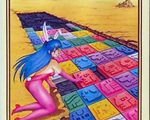
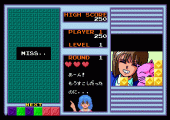
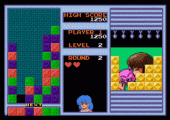
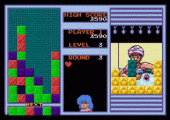
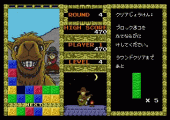
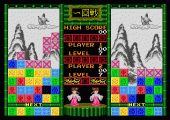
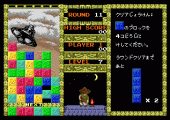
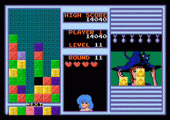
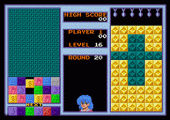
Recent Comments